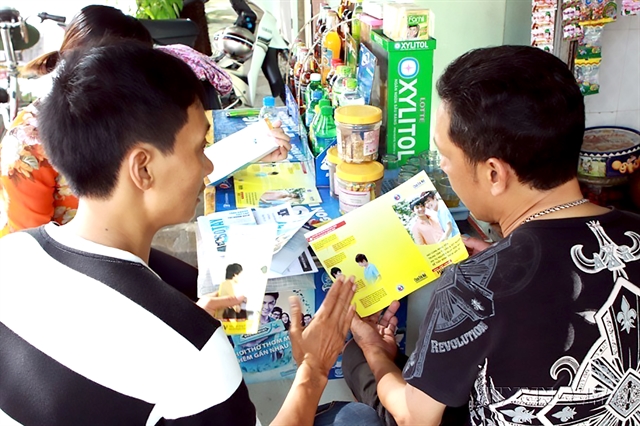 Society
Society

 |
| Men read leaflets on HIV/AIDS prevention and control in the northern port city of Hải Phòng. — VNA/VNS Photo Dương Ngọc |
HÀ NỘI — Việt Nam has been recognised as one of the few countries with the best HIV/AIDS prevention and treatment in the world.
The lead is the result of the participation of the entire political system and relevant forces, along with efforts of many community groups.
Associate Professor Phan Thị Thu Hương, Director of the Việt Nam Administration of HIV/AIDS Control (VAAC) under the Ministry of Health, said that at present, many HIV-positive people in Việt Nam belonged to vulnerable groups such as people who use drugs, sex workers and men who have sex with men (MSM).
They are easily discriminated against, so the State health system is more difficult to access.
Currently, the country has about 400 community groups, which play an important role in educating people about how to reduce the risk of contracting HIV and connecting individuals to treatment, along with providing free practical help.
The groups convince people with HIV to go for treatment, helping them overcome difficult times and reintegrate into life.
One of the key factors that help community groups be effective is close cooperation among members.
Experience and expertise sharing has enhanced the capacity of the overall system.
For example, the Việt Nam Network of People with HIV (VNP+) is a non-governmental organisation founded in 2009, which now has more than 300 affiliate member clubs across the country.
These clubs give technical support and provide advocacy for people living with HIV.
Thanks to this cooperation, members of the groups have improved their ability for testing consultation, mutual care and support and expanded epidemic surveillance for people at high risk in their areas.
Deputy Director of the Kiên Giang Centre for Disease Control Võ Thị Lợi said that without peers from the community groups, it was a big challenge to access at-risk people, while the risk of infection among MSM was increasing at an alarming rate.
Support
When receiving a positive HIV test result, Nguyễn Thúy Ng., who lives in Bình Thạnh District, HCM City, collapsed and felt like her life had stopped.
But when she met Ngô Thúy H., leader of the group 'For a brighter tomorrow', Ng. found joy again.
Ng. recalls that after her husband died of HIV, the community group suggested she also test and while waiting for the results, she became a hermit. The results were exactly as she predicted.
But the love and enthusiasm from the group helped Ng. regain the will to live and equip her with better knowledge and understanding about HIV/AIDS. Now, she herself is one of the active members of the group, helping and mentoring new members.
'Each day of living must be 24 hours of love and meaning' is the group's motto and is spread by all members of the group to bring hope to people living with HIV across the country.
Currently, the HIV infection rate among people who use drugs and MSM is one of the main sources of the HIV epidemic in Việt Nam.
Statistics from the VAAC showed that the HIV infection rate increased by sixfold between 2012 and 2020.
However, for many reasons, the MSM community cannot access and use services such as testing and treatment in the usual way.
Therefore, more than ever, community groups are the bridge to help people with HIV access services, get information and collect practical items such as needles and condoms.
Việt Nam is gradually transferring financial responsibility for HIV/AIDS prevention from international donors to domestic agencies, with community groups expected to become an indispensable pillar in the work needing to be done.
Experience from the COVID-19 pandemic proved the power of community network. When social distancing was applied, many people living with HIV had difficulty accessing antiretroviral drugs.
The network quickly called for volunteers and coordinated with local medical facilities to supply medicine to HIV patients’ houses.
Thanks to the timely support, thousands of people living with HIV did not have to interrupt treatment during the pandemic.
In addition, the community network also invited participation from the private sector and other resources, creating a diverse and sustainable ecosystem for HIV/AIDS prevention. — VNS




